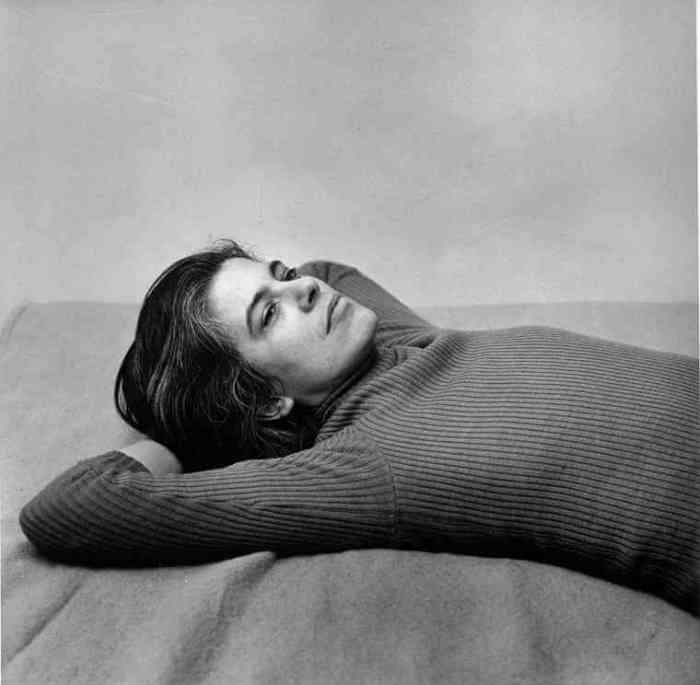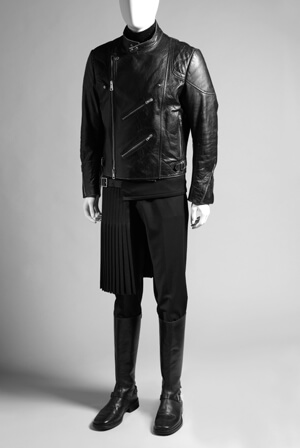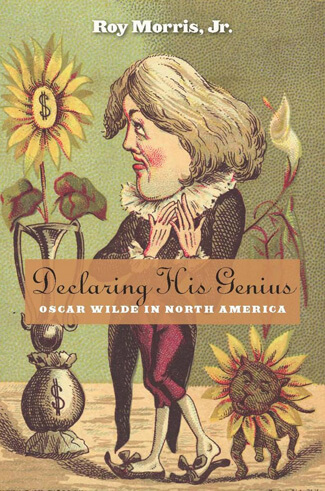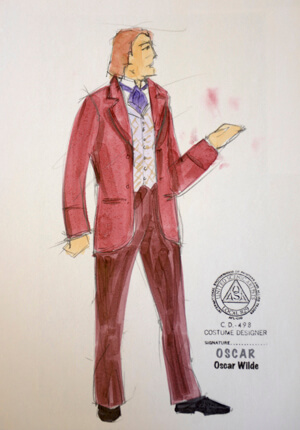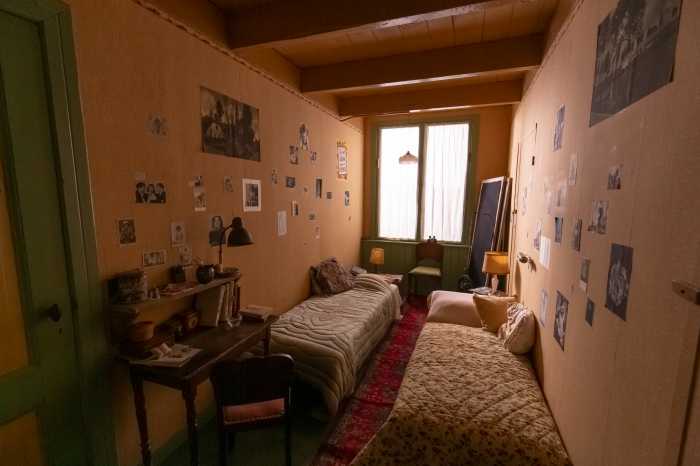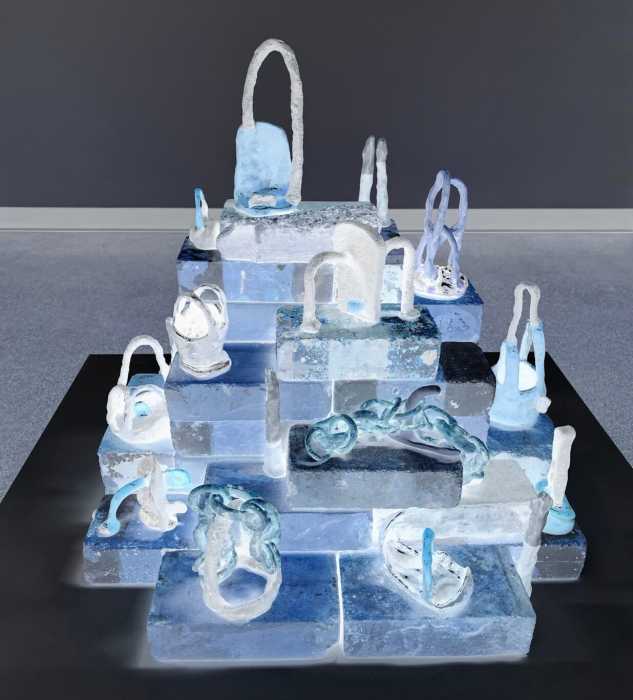Charlie Scheips with his new book “Elsie De Wolfe’s Paris: Frivolity Before the Storm” from Abrams. | DAVID NOH
Lady Elsie Mendl, nee De Wolfe, (1859-1950) — at various times in her life an actress, author, inveterate party hostess, and pioneering interior decorator — was universally considered one of the chicest women of her time. She enjoyed her pick of the leading couturiers vying to garb her (Schiaparelli was a favorite), the first to dye her hair blue, and a yoga advocate whose motto (as repeated by Ina Claire in “Ninotchka”) was “Never complain, never explain.”
The height of her style-setting reign was the 1930s, and it all peaked late in the decade with two consecutive circus-themed parties she threw in 1938 and 1939 at her home in Versailles, the Villa Trianon, which to this day remain legendary for their insanely scrupulous planning, opulence, and glittery guest lists. These parties form the nucleus of a sumptuous book by Charlie Scheips, “Elsie De Wolfe’s Paris: Frivolity Before the Storm” (Abrams), which deliriously sweeps you back to an ineffably elegant, gone-forever era immortalized in such 1939 classic films as “Midnight” and “Rules of the Game.”
The book’s genesis began, Scheips told me, when he was the director of the Conde Nast archive for a decade: “I started being intrigued by John McMullin [a close intimate of Mendl’s], who was the social writer for the magazines in the 1920s and 1930s. I did massive research on him and was going to publish a book about him before 9/11. He wrote a column called ‘As Seen By Him,’ and the reason he is forgotten is that it didn’t have his name attached to it, although he was the most prolific contributor in the history of Vogue. In 1930, he started taking photos of the rich at play to accompany his articles. After 9/11, the book got canceled and, when I left Conde Nast in 2003, I put my boxes of research in storage in my Dad’s house in Connecticut.
Lady Mendl’s swell soirees; Ginger lover; que rico!
“My life went in different paths and I eventually went back to Columbia to finish my masters’ in American Studies, and I wrote a 200-page thesis on McMullin which I still plan to turn into a biography. About two and a half years ago, I was cruising around the Internet looking at Getty images, and I stumbled upon photos of Lady Mendl’s party of July 1, 1939, taken by Time/ Life photographer William Vandivert, which had been misdated. They were amazing and I called up the director of Getty to see if there were any more.”
There were indeed more, and Scheips also recognized certain dresses on the guests that turned out to be the very ones given to the Metropolitan Museum Costume Institute by socialities like Mendl, Mona Bismark, and Mrs. Hector Munn, and are constantly dragged out as emblems of the height of couture.
“My friend Susan Train, who has been at Vogue Paris for six decades, fell in her apartment and was in bad shape so I flew to Paris to be with her. One night I asked her about this French photographer who had been at the same ball, Roger Schall, whose photos had appeared in Vogue. She said, “I know his son!” and gave me his number. Two days later, I’m in his studio looking at 250 never before published photos of the party, and as I studied them I realized that they were not from the same night. There were two parties in 1938 and 1939 with Elsie wearing different dresses.”
French actor Jean Marais (center), flanked by two of his sometime lovers, Jean-François Lefèvre-Pontalis (left) and Denham Fouts (right), making their grand entrance at Count Étienne de Beaumont’s Racine Ball, Paris, 1939. | ROGER SCHALL/ COURTESY: CHARLIE SCHEIP'S ELSIE DE WOLFE'S PARIS: FRIVOLITY BEFORE THE STORM/ ABRAMS
Scheips began conceptualizing a book about these two nights in a world that was “gone with the wind the minute the war came. I went back to Paris two summers ago and was desperate to find the man who owned Elsie’s house, the Villa Trianon. I did find him but he was very creeped out by this American guy with all this interest in his house. He’d been robbed, some mantelpieces had been stolen. Then a terrible storm happened and wreaked havoc on it and he didn’t have the money to restore it, and he said it was too dangerous to allow me to see it.”
Mendl’s name is largely forgotten, except by people in fashion and in interior decoration — a field she pretty much invented — but, as an overall taste-maker of her time, she ruled supreme.
“Everybody talks about the duchess of Windsor and how she was the style setter of the1930s, but McMullin had introduced her to Elsie, and she and Johnny totally restyled her, in terms of her clothes, interiors and entertaining. Elsie was the absolute queen of what I call International Society — this lesbian! — and I also proved that she was so much older than she said she was, almost 80 when she had this party, this old American dyke throwing this party in Versailles for 700 guests. So crazy, and the world around her was very gay or bisexual or whatever you want to call it. This was not talked about — everybody just knew and was very discreet — but it’s very hard to find a straight person involved in this story.”
De Wolfe married Sir Charles Mendl in 1926. It was the perfect arrangement with Charles at one point declaring, “For all I know the old girl’s still a virgin!” Scheips explained, “When she married, she was already 68 years old and realized that by being married to a French diplomat she could live totally tax-free. She was always smart about money.”
Before Sir Charles, Elsie had been part of a major lesbian power trio, consisting of herself, J.P. Morgan’s daughter Anne, and eminent literary agent Bessie Marbury, with whom she lived on Sutton Place. Scheips doesn’t think it was an actual, sexual menage a trois: “I tried to be very discreet and not make more of it than there was, but they were not closeted. Bessie and Ann had a mentor-older/ younger woman friendship, and Elsie was the star, the alpha female of the group. Bessie was a powerhouse, incredibly successful with George Bernard Shaw, Oscar Wilde, and Victorien Sardou among her clients. When Oscar got out of jail, she had saved his royalties and was the only one who gave him money. She and Elsie offered him an outbuilding near the Villa Trianon to live in as he was penniless, but he wanted to live in Paris, not Versailles.
“Anne had all the money from her father. Bessie and Elsie were best friends growing up together. Bessie mentored Elsie as a decorator and everything went swimmingly until World War I when Anne and Elsie got more involved in the war effort. Bessie was obese and in poor health, so she stopped traveling and became involved in Democratic politics and Catholic charities. She produced Cole Porter’s first musical.
“Anne and Elsie got the Legion d’honneur and Red Cross medal for their hands-on work. They were really at the front with burn victims and rotting flesh, not just rich ladies buying ambulances. Anne later bought the Chateau Blérancourt which is now the museum of French-American friendship, her obsession.”
Beginning her decorating career, Mendl did the houses of her friends on Sutton Place, and then Morgan and Marbury started the Colony Club, which really started her decorating success.
“She did Conde Nast’s apartment at 1040 Park, as well as rich American women, the first or second generation wives of robber barons who wanted her taste from California to New York,” Scheips said. “She was the original brander, years before Martha Stewart, endorsing cigarettes, radios, cars — an incredible dynamo.”
Scheips did eventually get to see the Villa Trianon: “After I handed the manuscript for the book, the owner, whose trust I had gained by then, allowed me to come see it last May. It had been restored three times: when Elsie first found it in ruins, then it became a hospital in World War I, and then was occupied by Nazis in World War II. An extraordinary day, her pet cemetery was there. Elsie used Villa Trianon as her Petri dish of ideas. It kept evolving and when she and Bessie first moved there they had an outdoor dining terrace off the main house, which was 18th century. She covered that, then glassed it in. Her original dining table was featured in her 1915 book, ‘House of Good Taste,’ and I was walking around on this rainy day, with all the overgrown topiary and trees which hadn’t been cut in 50 years, when I saw that great stone table by one of the stables. Only I would have known that!
“On her bedroom door, there’s still the little sign which says ‘Moi,’ there are shadows of where pictures used to hang. No furniture but the curtains are still hanging. I sent the owner a picture of Cole Porter sitting at that table. He was thinking of dividing the property up as luxury villas of Versailles to get his money back. But by end of the summer, when I showed him the manuscript, he was so taken by what I had done that he has decided to restore the house to its former glory and wants to consult with me about this. So there’s a whole amazing post-book story!”
Ginger Rogers and James Stewart in George Stevens’ 1938 1938 “Vivacious Lady.” | MUSEUM OF MODERN ART
MoMA continues its exploration of the work of Hollywood icons in its “Acteurism” series with a selection of Ginger Rogers movies. One of the most instantly likable, appealing and sexy female presences in her early career, she’s at her non-musical peak in Gregory La Cava’s 1937 “Stage Door” (Feb. 18-20, 1:30 pm.). La Cava was an improvisational wiz at mining his actors’ real personalities and quirks, and he perfectly pits proletariat darling Rogers (with absolute killer comic timing) against patrician Katharine Hepburn, amusingly demonstrating every quality which would make her box office poison the following year. The two stars were also romantic rivals off-screen, simultaneously dating Howard Hughes, which lends an extra edge to this endlessly enjoyable film, which, before “All About Eve,” was Hollywood’s best evocation of New York life on the boards. Rogers’ real-life BFF, Lucille Ball, gives her first effective screen performance here: you see Lucille literally becoming Lucy.
Rogers is also entrancingly herself in George Stevens’ 1938 “Vivacious Lady” (Feb. 25-27, 1:30 p.m.), showing why Elsa Schiaparelli described her at the time as the perfect American woman. Every actress at the time wore a pageboy, but no one wore it better than Rogers. Stevens’ direction has its typical, maddeningly logy moments, but Rogers, showing Beulah Bondi how to do the Big Apple or decimating Frances Mercer in a bitch fight, kills.
Rogers’ “Kitty Foyle” (Mar. 4-6, 1:30 p.m.) won her the 1940 Academy Award, somewhat unbelievably, as it bested not only Bette Davis’ “The Letter” and Katharine Hepburn’s “The Philadelphia Story,” but the spectacular, non-nominated Rosalind Russell in “His Girl Friday,” Margaret Sullavan in “The Shop Around the Corner,” Vivien Leigh’s “Waterloo Bridge,” and even Rogers’ own superior performance in “The Primrose Path.” She’s good in this popular soapera, but I feel the Oscar was an early death knell to her career.
After 1942, her talent, now officially anointed by that naked gold man, seemed to mystifyingly dry up, along with her own sense of humor, as she began to take herself very seriously, with unintentionally risible grande dame mannerisms and attitudes, as well as a much heavier comic attack, to match that of the Queen herself, Greer Garson. “Lady in the Dark” (Mar. 11-13, 1:30 p.m.), from 1944, is submitted as evidence. What undoubtedly was a smashingly chic, airy lark on stage with Gertrude Lawrence became a two-ton, lavishly vulgar thud onscreen, framing a heavily imperious star who seemed to have forgotten an essential fact: musicals should be fun. (11 W. 53rd St.; moma.org/visit/calendar/films/1552)
I adore South American food so was positively rejoicing at the opening of K*Rico on February 4. Perfect for theater dining at its 51st and Ninth Avenue location, it’s an elegant, sophisticated jewel with super-succulent eats, like the five different cuts of wet and dry aged prime USDA beef I positively devoured. Featuring genius star chef Steven Cruz and owned by Christian Tanno and the Greco brothers, John and Tommy, who owns the justly popular Ritz Bar and Lounge, it’s a welcome addition to the neighborhood. I loved the fantastically stocked bar where you can discover a very rico Latin world of tequilas, mescals, and piscos. (kriconyc.com)




